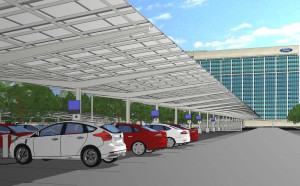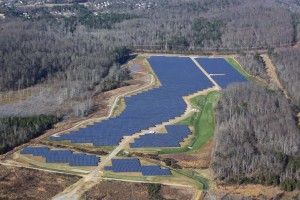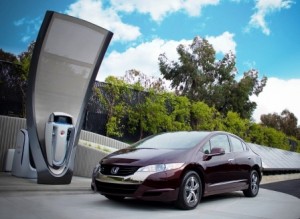Ford Motor Co. has been betting big on battery power, and now it’s tapping the sun to help charge up some of its electric vehicles with a sprawling new solar energy array it plans to install outside its suburban Detroit headquarters.
Ford is the latest in a growing list of manufacturers turning to solar energy at their office buildings and manufacturing plants. General Motors is even using sun power to help charge up newly assembled Chevrolet Volt plug-in hybrids before shipping them off to customers. And solar energy is providing a major chunk of the power needed to run Volkswagen’s big assembly plant in Tennessee.
Ford has “a deep commitment to sustainability,” explains Chairman Bill Ford Jr. The maker’s “beliefs are embodied in this project,” he stressed.
Working with local power supplier DTE Energy, Ford’s new solar array will be the largest in Michigan and the second-largest in the Midwest, covering 360 parking spaces in front of the headquarters building known locally as “Glass House.” In all, it will be able to produce up to 1.038 megawatts of energy.
That would be enough to power 158 average-sized homes, the maker notes, adding that some of the energy will be tapped for 30 electric vehicle charging stations. Ford currently produces several different battery-based models, including the Focus Electric battery-electric vehicle, and the C-Max Energi plug-in hybrid.
(Small start-up company wants to pave the country with solar road blocks. Click Here for the rest of the story.)
DTE will manage the “Solar Currents” facility once it goes into operation in 2015. Though the energy supplier aggressively opposed a ballot measure last year to mandate the increased use of renewable power, it has committed to generating 10% of its energy from non-fossil sources by next year.
Ford already has a 500-kilowatt solar array in operation at its suburban Detroit Michigan Assembly Plant where it builds its various battery-cars.
The maker also has won kudos for the innovative design of its Dearborn Truck Plant for the use of such environmentally friendly features as a “living roof” which is covered with 11 different plant species. The approach reduces rain run-off and lowers both heating and cooling requirements.
A number of automakers have been turning to sun power, including cross-town rival General Motors, which has set up a large solar array at its Detroit-Hamtramck Assembly Plant, where it produces the Chevy Volt. New plug-ins tap some of that energy when they are charged up prior to be seeing shipped to dealers.
Several Volkswagen divisions, including its luxury brand Audi, have added large solar arrays at their plants around the world. The maker last year switched on the 33-acre Chattanooga Solar Park outside its Tennessee assembly facility, which it dubbed “the world’s greenest auto plant.”
The park contains 33,600 solar modules designed to produce 13.1 gigawatt hours of electricity a year — equivalent to the energy consumed annually by 1,200 homes in the area. The electricity produced from the solar park is expected to meet 12.5% of VW’s Chattanooga plant needs during full production and 100% at non-production periods.
(Click Here for more on VW’s Solar Park.)
Honda, meanwhile, is using solar power to produce hydrogen for use in its older FCX fuel-cell vehicles, and for the new hydrogen-powered model it will begin marketing in Southern California next year.
Meanwhile, the Japanese maker has teamed up with Solar City, the sun power company partially funded by entrepreneur and Tesla Motors founder Elon Musk. The maker early last year agreed to invest $65 million into the company, with the goal of offering customers in 14 states low-cost home solar charging stations for their electric vehicles.



